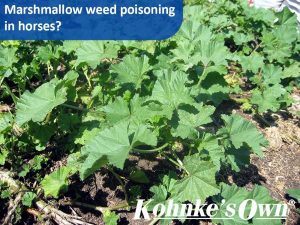Malva parviflora, known as small flowered mallow or marshmallow weed is a naturalised, invasive weed of crops and pastures. It is often found around the fence lines of yards where it flourishes in the organic matter from manure and moisture around the perimeter. It has a deep tap root which enables it to persist as a perennial weed and emerge quickly with succulent leaves after rain. Small flowered mallow has been implicated as the cause of poisoning cases in horses, sheep and cattle. The incidence is rare as the plants are usually unpalatable with young animals most at risk of poisoning from small-flowered mallow. The specific toxin that causes poisoning in the plant is still unknown.
Small flowered mallow is an upright or sprawling annual weed that grows to 50 cm in height. The leaves are alternately arranged along the stem and they may be covered in sparse hairs. The rounded leaves are lobulated and they can grow up to 8 – 10 cm in diameter in mature plants. The plant flowers in spring, with mauve, pink or white clustered flowers. The flowers have 5 petals and are surrounded by a cup-shape structure. The small seeds less than 2 mm diameter are not crushed by a horse’s teeth and 90 % of the seeds can be passed viable in the droppings for up to 13 days after ingestion.
Signs of Marshmallow Weed Poisoning
Signs of marshmallow weed poisoning include; profuse sweating, rapid breathing, incoordination and muscle tremors. Some horses develop mild diarrhoea because of its laxative effect. The symptoms worsen when the animal is forced to move or is put under stress. If only a small amount is ingested, most animals are able recover when rested and access to small flowered mallow is restricted. Veterinary attention should be sought if small flowered mallow poisoning is suspected in a horse. Treatment and supportive care may help with recovery.
Other Risks of Marshmallow Weed
During rapid growth and under certain environmental conditions, such as warm sunny days and freezing nights, marshmallow weed can accumulate fructan sugars and it can be a risk for laminitis in susceptible horses. There have been veterinary reports in Australia of horses developing severe, acute laminitis after ingestion of the weed. Hungry, bored horses might consume large quantities of the weed, especially if environmental conditions have made the normally unpalatable plant particularly ‘sweet’. The fructan sugars are not digested in the small intestine and are overloaded into the hind gut to ferment to D-lactic acid, leading to hindgut lining damage and toxin uptake.
How to Control Marshmallow Weed
Avoid grazing horses on pastures infested with marshmallow weed. Individual plants can be pulled out by hand or spot sprayed with herbicide. The use of herbicides can be an effective control measure for larger infestations. Seek advice from a local agronomist or weed management agency to select the most appropriate herbicide and spray program for your property. The plant is very hard to control once is has matured, so early control soon after the plant has first emerged is important. It is best to remove horses from areas where marshmallow has been sprayed, and if the small flowered mallow plants are pulled out by hand they should not be left in the paddock. A good way to control small flowered mallow is to establish and maintain good ground cover of pasture and to keep fence lines and yards free of weeds.

References: Bauguier J et al. (2017) Evidence for marsh mallow (Malva parviflora) toxicosis causing myocardial disease and myopathy in four horses. Equine Vet J 49(3) 307-313
